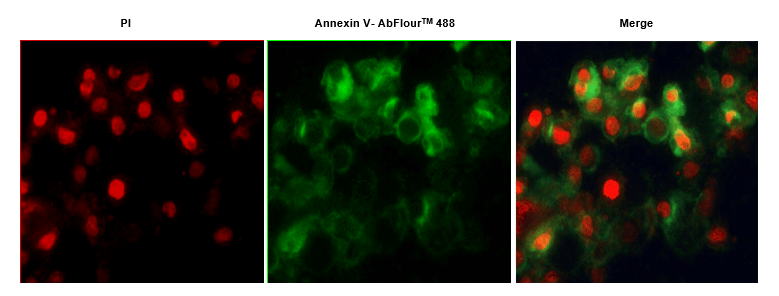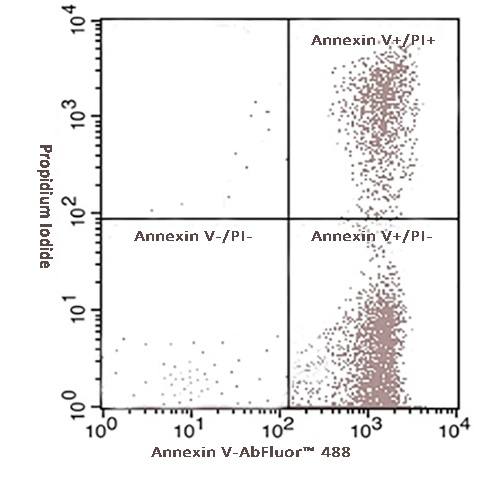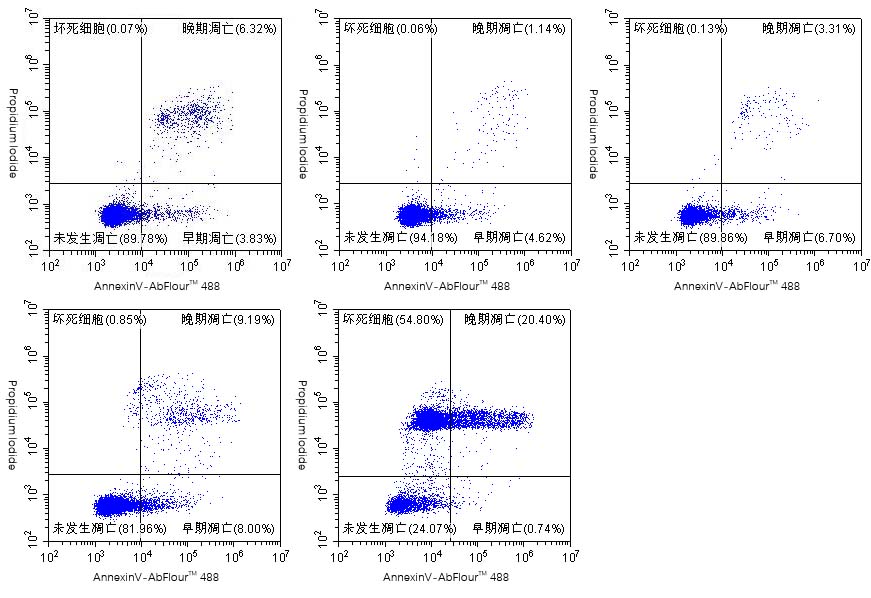| Product name | Annexin V-AbFluor™ 488/PI Apoptosis Detection kit |
| Applications notes | Abbkine Annexin V-AbFluor™ 488/PI Apoptosis Detection kit contains Annexin V labeled with Abbkine proprietary green fluorescent dye AbFluor™ 488, which allows the identification and quantitation of apoptotic cells by flow cytometry or fluorescence microscopy. Simultaneous staining of cells with AbFluor™ 488 and propidium iodide (PI) allows the discrimination of intact cells, early apoptotic and late apoptotic or necrotic cells. |
| Alternative | Annexin 5; Annexin V; AbFluor™ 488 |
| Kit components | • Annexin V Binding Buffer (5×) • Annexin V-AbFluor™ 488 • Propidium Iodide (PI) • Apoptosis Inducer A •Apoptosis Inducer B |
| Features & Benefits | • Abbkine AbFluor™ 488 dye is superior to FITC as it is brighter, not affected by pH, and has much better photostability • Annexin V- AbFluor™ 488: Abs/Em = 491/517 nm; PI: Abs/Em = 535/617 nm (with DNA) • Suitable for flow cytometry or fluorescence microscopy |
| Storage instructions | Stable for at least 12 months at -20°C from date of shipment. Protect from light. |
| Shipping | Gel pack with blue ice. |
| Precautions | The product listed herein is for research use only and is not intended for use in human or clinical diagnosis. Suggested applications of our products are not recommendations to use our products in violation of any patent or as a license. We cannot be responsible for patent infringements or other violations that may occur with the use of this product. |
| Background | Apoptosis is a form of programmed cell death to remove unwanted, damaged, or senescent cells from tissues. In normal cells, the negative phospholipids reside on the inner side of the cellular membrane while the outer surface of the membrane is occupied by uncharged phospholipids (PS). After a cell has entered apoptosis, the negatively charged PS are transported from the inner to the outer leaflet of the plasma membrane, thus exposing PS to the external cellular environment. The human anticoagulant, Annexin V, is a 35–36 kDa Ca2+-dependent phospholipid-binding protein that has a high affinity for PS. Annexin V labeled with a fluorophore or biotin can identify apoptotic cells by binding to PS exposed on the outer leaflet. Propidium iodide (PI) is a membrane-impermeant DNA-binding dye that is commonly used to selectively stain dead cells in a cell population. PI is excluded by live cells and early apoptotic cells, but stains necrotic and late apoptotic cells with compromised membrane integrity. PI can be excited by the 488, 532, or 546 nm laser lines, and emits red fluorescence. |
| Alternative | Annexin 5; Annexin V; AbFluor™ 488 |

Fig.1. Hela cells were induced with camptothecin for 24 hours and stained with Annexin V- AbFluor™ 488/PI Apoptosis Detection Kit. The cell is a late stage apoptotic/necrotic cell with both Annexin V- AbFluor™ 488 and PI staining (green membrane with red fragmented nucleus).

Fig.2. Hela cells were induced with camptothecin for 24 hours and stained with Annexin V- AbFluor™ 488 Apoptosis Detection Kit. The combination of AbFluor™ 488 and propidium iodide allows for the distinction between early apoptotic cells (Annexin V- AbFluor™ 488 positive), late apoptotic and/or necrotic cells (Annexin V- AbFluor™ 488 and propidium iodide positive), and viable cells (unstained).

Fig.3. Hela cells were induced with camptothecin of 4 different concentration(0、1:8000、1:4000、1:2000、1:1000) for 24 hours and stained with Annexin V- AbFluor™ 488 /PI Apoptosis Detection Kit. The combination of AbFluor™ 488 and propidium iodide allows for the distinction between early apoptotic cells (Annexin V- AbFluor™ 488 positive), late apoptotic and/or necrotic cells (Annexin V- AbFluor™ 488 and propidium iodide positive), and viable cells (unstained).
Author:Zou H, Luo J, Guo Y, et al Publication name:Drug Resistance Updates IF:24.3
Author:Tian, Zhangyu, et al. Publication name:Autophagy IF:14.300
Author:Wang, Xiaofei, et al. Publication name:Redox Biology IF:11.4
Author:Cao, Li-Hua, et al. Publication name:Phytomedicine IF:8.300
Author:Dong, Xinrui, et al. Publication name:Journal of Translational Medicine IF:7.4
Author:Li F, Wang Y, Xu M, Hu N, Miao J, Zhao Y, Wang L. Publication name:Ecotoxicology and Environmental Safety IF:7.129
Author:Jia, Lina, et al. Publication name:Ecotoxicology and Environmental Safety IF:6.8
Author:Guo, CanCan, et al. Publication name:Ecotoxicology and Environmental Safety IF:6.8
Author:Zhou J, Zhang Y, Zeng L Publication name:Ecotoxicology and Environmental Safety IF:6.793
Author:Yang, Chen, et al. Publication name:Cancer Cell International IF:5.8
Author:Li Y C, Liu S Y, Meng F B, et al. Publication name:Foods IF:5.561
Author:Huang, Huizhong, et al. Publication name:Food & Function IF:5.3999
Author:Li Y C, Liu S Y, Li H R, et al Publication name:Foods IF:5.2
Author:Zhang S, Li E, Liu Z, et al. Publication name:Journal of Drug Delivery Science and Technology IF:5.062
Author:Likitsatian, Tanrada, et al. Publication name:Nutrients IF:5.000
Author:Yang, Qiqi, et al. Publication name:International Immunopharmacology IF:4.7003
Author:Ravish A, Narasimhachar B C, et al Publication name:Biomedicines IF:4.7
Author:Chen, Li, et al. Publication name:Frontiers in Microbiology IF:4.5003
Author:Meng C, Chen G, Liu Y Publication name:Microorganisms IF:4.50
Author:Jing X, Du T, Li T Publication name:J Cell Mol Med IF:4.486
Author:Liu, Jia, and Chong Wang Publication name:Journal of Ovarian Research IF:4
Author:Shiwei Yang, Shanyu Gao, Tongming Liu Publication name:Cell Cycle IF:3.699
Author:Shukla, Alok, et al. Publication name:Medical Oncology IF:3.500
Author:Jin X, Fu W, Li D, Wang N, Chen J, Zeng Z, Guo J, Liu H, Zhong X, Peng H, Yu X, Sun J, Zhang X, Wang X, Xu B, Lin Y, Liu J, Kutter C, Li Y Publication name:Onco Targets Ther IF:3.337
Author:Wang, Fujue, et al. Publication name: Frontiers in Oncology IF:3.3000
Author:X Jin, W Fu, D Li Publication name:Onco Targets Ther IF:3.259
Author:Wang Y, Wen J, Sun X, et al Publication name:Cancer Chemotherapy and Pharmacology IF:3
Author:Zhang, Di, et al. Publication name:Experimental Eye Research IF:2.7001
Author:Pan J, Wu T, Chen B, Wu H. Publication name:Histology and histopathology IF:2.13
Author:Derangula, Somasekhara, and Varalakshmi K. Nadumane. Publication name: Asian Pacific Journal of Tropical Biomedicine IF:1.7001
Author:Wang, Xiao-Hui, et al. Publication name:Journal of Asian Natural Products Research IF:1.300
Author:Li, Che, et al. Publication name:Bratislava Medical Journal IF:1.1001
Author:SP Chirakkara, A Abraham Publication name:Journal of Applied Pharmaceutical Science IF:0.8
You must be logged in to post a review.
Reviews
There are no reviews yet.